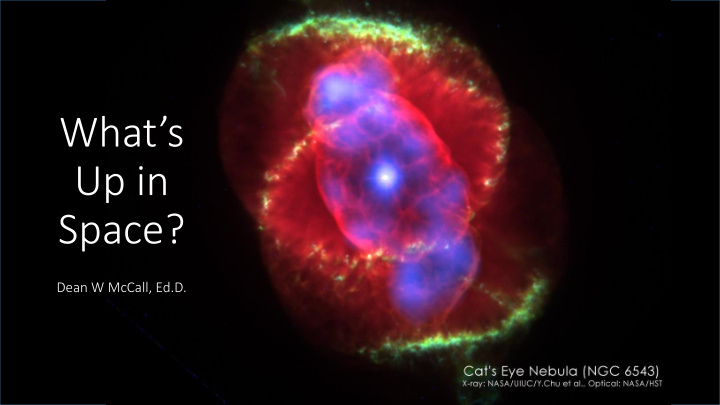



What’s Up in Space? Dean W McCall, Ed.D.
In no particular order… • Brief aerospace CV • Systems Engineering • Space mission types • Examples • Gotchas • Terminology & Slang Please ask questions
McCall Background • Hughes Space & • BS in Computer & Electrical Communications 1988-2000 Engineering • Boeing Satellite Systems 2000- • MS in Electrical Engineering 2012 • MBA • Ball Aerospace 2012-present • Ed.D., Organizational Leadership • Manager, Space Systems
Ball Contributions to Missions • New Horizons – Pluto close-ups – Ralph instrument, camera • Spitzer Space telescope • Cryogenic Telescope Assembly (CTA) • The telescope, and two of the three science instruments embedded within the CTA: the Infrared Spectrograph and the Multiband Imaging Photometer. • Hubble Space Telescope • Two star trackers, five major leave-behind equipment subsystems • Each of the five science instruments now operating on the telescope were Ball-designed and built. • Ball also fixed the early problem with the imaging system • Kepler/K2 – exoplanet discoveries; Ball built the observatory • Deep Impact • James Webb Space Telescope optics • Worldview spacecraft • NPP spacecraft
What it Takes • Systems Engineering* • Systems Thinking applied to • Math Engineering • Physics • Addresses complexity • Initially driven by the Apollo program • Chemistry • Four key facets • Logic • Technical • Rational/Logical • Social • Coding • Intuitive • Quality, cost, schedule, risk • Optimized trade space * …and several other types of engineering
Hughes & Boeing Missions • UHF Follow-On • Galaxy 8i • Galaxy X (1) • Spaceway/DirecTV • XM Radio 3 (Rhythm) • XM Radio 4 (Blues) • New Skies 8 (1) • Protostar • TDRS K/L (1) Lost during launch
XM Radio • XM 3, 4 (XM Rhythm, Blues) • Boeing BSS-702 model • 13.3 kW • 15-year mission life • 5193 kg (11,448 lbs) • Geosynchronous orbit
Geosynchronous Orbit • Satellite flies around the equator at the same rate the 3,959 miles earth turns 22,232 miles • Over 900 satellites in the Geo belt Circumference = 2 λ r, where r=radius of the circle. r = 3595 + 22,232 = 25,827 miles from earth center λ = 3.1415926535897932384626433832795… Geosynchronous path is 162,276 miles around 24 hour orbit Satellite flies at 162,276/24 = 6,761 miles/hour
Space Environment Launch Environment • Extreme temperatures • High vibrations & noise • Vacuum • High g-forces • Little to no gravity: “zero - g” • Molecular heating • High radiation (solar & cosmic) • Outgassing • Big challenge for human space • Failures flight https://www.youtube.com/watch?v=M7wBN-U2KXI • 3 out of 85 launches in 2016 • Debris (meteoroids, manmade) • 8.08% historically • 6.68% in the past 20 years
Gotchas • Space junk • Meteoroids & micrometeoroids • Radiation
Spacecraft Anatomy Car Spacecraft Mission get there telecommunications, science, intelligence Payload You, cargo RF (radio frequency), optical, UV/IR/gamma/etc. Power Alternator, battery Solar cells, battery Propulsion Engine Thruster Fuel gas, diesel MMH, NTO, Xe Structure metal, composite, plastic metal, composite, plastic Materials low cost exotic & high cost Guidance & Control You Autonomous Guidance, Navigation & Control Sensors You, gauges light sensors, accelerometers Actuators steering, brakes thrusters, reaction wheels, magnetic torquers Temperature control heater, radiator heater, radiator Wiring wire harness wire harness, fiber Repair accessible not physically accessible once flying Cost $Thousands $Millions
Deployments • JWST https://youtu.be/bTxLAGchWnA • Solar Dynamics Observatory https://youtu.be/VBf_WsHTH_c • Orion/cubesats https://youtu.be/FhzyIWKvo9Q • SMAP antenna 20’ https://youtu.be/FhzyIWKvo9Q • Viasat-1 https://youtu.be/xfZ-a1iMsnQ • Gaia sunshade https://youtu.be/UzV0vl2oKus • Dragon solar panels https://youtu.be/hBl5bBTqQuI • Ten Tech solar panels https://youtu.be/UxaA5VlchZI
Backup
Terms & Slang • Mass (in kg) • Cradle to grave • Telemetry & Command • Spin up • Outgassing • Screw the pooch • Delta V • FUBAR • Ephemeris • Going “nonlinear” • Degrees Kelvin • Absolute zero = -459.69°F • Redundancy
Other Orbits High earth & geosynchronous orbit (≥22,232 miles) • Circular mid earth orbit (1242 – 22,232 miles) low earth orbit (111 – 1242 miles) • Eccentric • Inclined • Deep space (not an orbit per se)
Recommend
More recommend